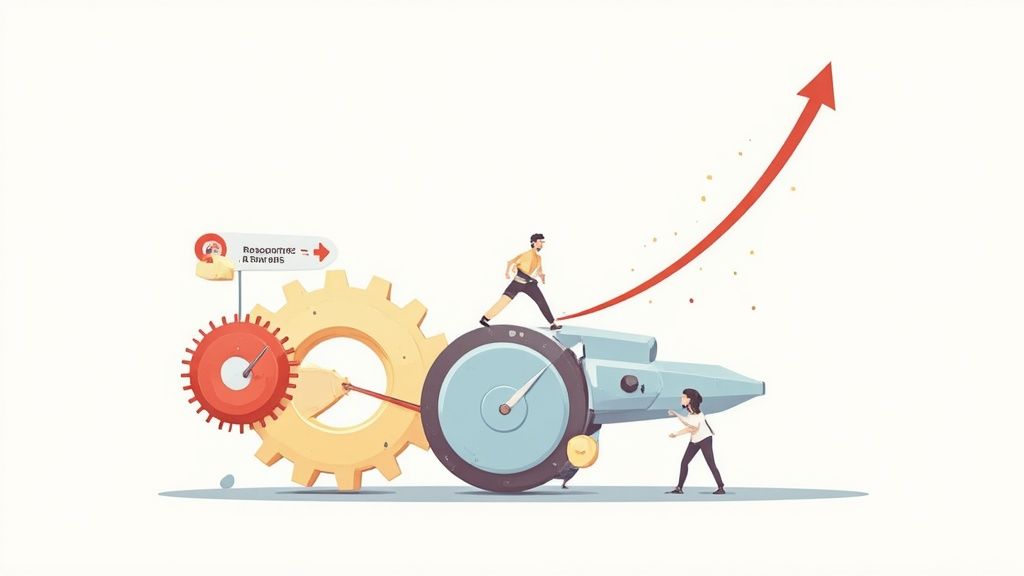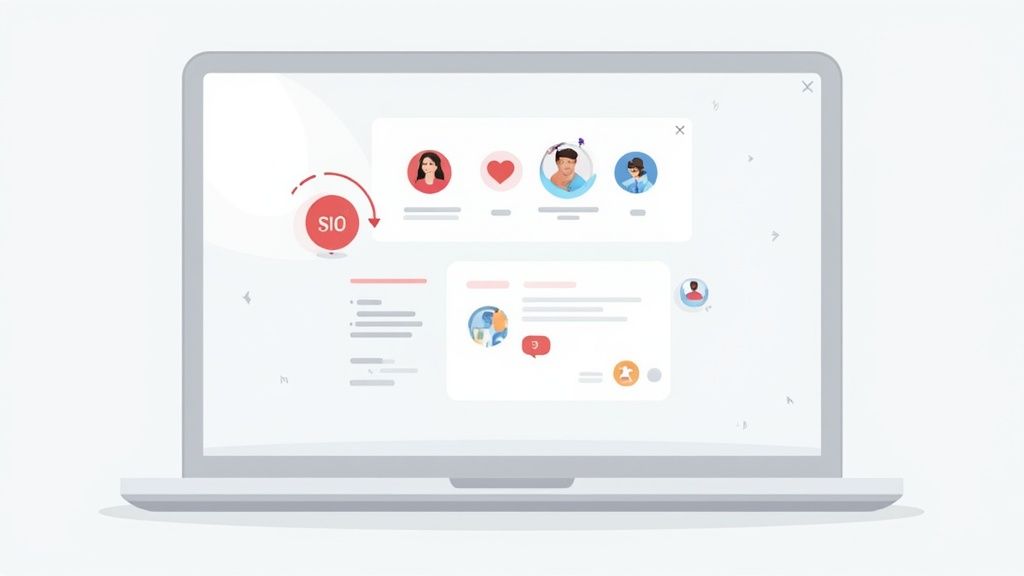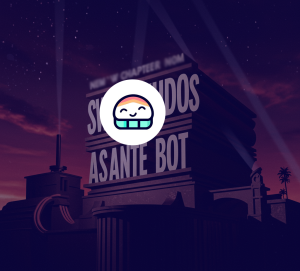Let’s think about your company for a second. If it were a high-performance engine, what fuel would keep it running at its peak? The answer is recognition and rewards. This isn’t just about handing out gift cards; it’s a powerful strategy for turning potential into top-tier performance and ambition into real, measurable achievements.
Table of Contents
How Appreciation Drives Business Growth

At its core, a recognition and rewards program is one of the most effective communication tools you have. It sends a crystal-clear message to your employees about what behaviors and results the company truly values.
When you publicly praise someone for their excellent teamwork or a clever solution to a tough problem, you’re doing more than just making that one person feel valued. You’re holding up a beacon for everyone else to see. This helps align the entire organization, guiding everyone’s efforts toward the goals that matter most and turning abstract company values into concrete, everyday actions.
The Key Difference: Recognition vs. Rewards
Though people often use the terms interchangeably, recognition and rewards play two very different, yet equally important, roles. Getting the balance right is the secret to a program that actually works.
- Recognition is all about acknowledging an employee’s specific contribution in a timely, and often public, way. It’s the act of saying, “I saw what you did there, and it was fantastic.” This is the psychological boost—it lifts morale, encourages great behavior, and makes people feel like they truly belong. For example, a manager sending a specific, public “thank you” message in a team chat channel right after a successful presentation.
- Rewards are the tangible items you give someone for hitting a major goal or milestone. Think bonuses, gift cards, or even extra vacation days. Rewards are the concrete incentive, the memorable celebration of a job well done. For example, giving a salesperson a monetary bonus for exceeding their quarterly sales target by 20%.
Here’s a simple way to look at it: Recognition is the heartfelt “thank you” speech at the awards ceremony. The reward is the trophy itself. You need both for the moment to feel complete and meaningful.
The Critical Importance of Team Recognition
Praising individuals is essential, but celebrating team wins is just as critical, especially in today’s collaborative workplaces. The biggest victories are almost always a group effort, and failing to acknowledge the entire team can lead to feelings of resentment and undermine the very collaboration you want to encourage. Team recognition reinforces the idea that collective success is the ultimate goal.
When you celebrate an entire project team for pulling together to meet a tough deadline, you’re not just rewarding the outcome; you’re strengthening the bonds between team members and building a culture where everyone feels accountable for the group’s success. This fosters a powerful sense of shared purpose and makes everyone more eager to cooperate on the next big challenge.
For example, imagine a software team that just launched a complex new feature. Rewarding them with a team lunch and a shout-out in the all-hands meeting is a simple but powerful way to acknowledge their collective hard work. It shows the whole company that you value synergy and teamwork, not just individual heroics.
Employee recognition has really become a cornerstone of a healthy company culture. In fact, a recent study found that 86% of U.S. employees received some form of recognition in the past year, with most valuing authenticity and personalization above all else. You can find more employee recognition trends and statistics here. This shift proves that genuine, heartfelt acknowledgment is what truly connects with people and drives engagement for the long haul.
Why Valuing Your People Is a Hard-Nosed Business Strategy
Thinking of employee recognition as a “nice-to-have” is one of the most common—and costly—mistakes a business can make. It’s not about feel-good gestures; it’s a strategic lever that directly impacts your bottom line. When people feel genuinely seen and appreciated, they don’t just feel better. They work better.
This isn’t some abstract HR theory. Creating a culture where appreciation is the norm sets off a chain reaction that strengthens every part of your organization, from individual performance all the way to customer satisfaction. It’s a direct investment in the human engine that drives your company forward.
Slash the Staggering Cost of Turnover
Let’s start with the most obvious win: keeping your best people. The cost of replacing an employee is brutal, often running anywhere from half to double their annual salary once you add up recruiting fees, training time, and lost productivity. A solid recognition program gives people a powerful reason to stick around.
It’s amazing what a little appreciation can do. Employees who feel recognized are a whopping 56% less likely to be job hunting. It’s not always about the paycheck; it’s about feeling like you matter.
A practical example: Imagine a marketing manager who receives a public shout-out from the CEO in a company-wide email after a killer campaign. That simple, zero-cost act builds a level of loyalty that a competitor’s bigger salary offer might not be able to break. Just like that, you’ve saved the company thousands in hiring costs.
Fuel Productivity and Performance
Valued employees are motivated employees. It’s that simple. When people know their hard work won’t disappear into a black hole, they dig deeper, push harder, and bring more creative ideas to the table.
A practical example: Think about a sales team that embraces peer-to-peer recognition. One salesperson publicly thanks a colleague in their team channel for helping them research and land a tough client. This small act doesn’t just make two people feel good; it reinforces a culture of collaboration. Suddenly, everyone is more willing to help each other out, which lifts the entire team’s performance and, ultimately, drives more revenue.
A landmark study revealed that employees who receive strong recognition report an 89% higher sense of determination and drive. That’s a direct line to a more engaged, efficient, and goal-oriented workforce.
Create Raving Fans, Not Just Customers
There’s an unbreakable link between how you treat your employees and how they treat your customers. Happy, engaged people deliver better service—period. They’re more invested in the company’s success and genuinely care about getting a great result for the customer.
A practical example: Picture a customer support agent who is consistently praised for their knack for solving tricky problems. When a frustrated customer calls in, that agent is far more likely to go the extra mile, patiently turning a bad experience into a great one. That single interaction can create a loyal customer for life, leading to repeat business and glowing referrals.
It’s no wonder that companies are starting to put real money behind this. The common wisdom is to allocate at least 1% of your total payroll to recognition initiatives. The global market for these platforms hit $15.8 billion in 2022 and is on track to explode to $65.3 billion by 2032, and you can discover more insights about employee recognition statistics on Vantage Circle. The trend is crystal clear: investing in your people isn’t an expense; it’s one of the smartest financial plays you can make.
Your Toolkit of Recognition and Reward Ideas
Building a great recognition and rewards program is a bit like packing a toolkit for a big project. You wouldn’t use a sledgehammer to hang a picture frame, right? In the same way, a one-size-fits-all approach to appreciation just doesn’t work. The real magic happens when you have a variety of options that fit different situations, personalities, and, of course, budgets.
A well-stocked toolkit means you can be both agile and authentic. Sometimes, a quick, informal “thank you” is all it takes to make someone’s day. Other times, a huge achievement deserves a much bigger celebration. Let’s break down the different tools you can use to build a program that feels both structured and spontaneous.
Informal vs. Formal Recognition
First up, let’s look at the difference between casual, everyday praise and the more structured, official awards. You absolutely need both for a healthy company culture.
- Informal Recognition is the daily heartbeat of appreciation. It’s timely, happens often, and usually comes from peers. Think of a quick “great job on that presentation!” in a Slack channel, a handwritten note left on a desk, or a shout-out during a team huddle. These small gestures are powerful because they’re immediate and reinforce great work right in the moment.
- Formal Recognition is more buttoned-up and tied to specific, pre-defined accomplishments. This is your “Employee of the Month” program, your annual performance awards, or the bonuses for smashing sales targets. These are the milestone celebrations that mark significant contributions, and they’re typically more public and ceremonious.
A balanced program needs a healthy mix. If you only rely on formal awards, recognition can feel rare and out of reach. But if you only use informal praise, you might not be properly celebrating those game-changing wins.
Monetary vs. Non-Monetary Rewards
Next, it’s crucial to understand the difference between tangible, financial rewards and other valuable forms of appreciation. It’s a common mistake to think money is the only thing that motivates people. While a bonus is always welcome, research consistently shows that non-monetary rewards can have an equally powerful—and sometimes more lasting—impact on morale.
This is because genuine appreciation feeds into our core need to feel valued, which directly fuels loyalty and, ultimately, business success.

As you can see, investing in your team’s sense of value isn’t just a “nice-to-have” cultural initiative; it’s a direct path to strengthening your company’s future.
Here’s a quick rundown of examples for your toolkit:
- Monetary Rewards: These are your direct financial incentives.
- Performance bonuses for exceeding goals
- Gift cards to a favorite restaurant or local shop
- Spot awards for clever problem-solving
- Profit-sharing or stock options
- Non-Monetary Rewards: These focus more on experience, opportunity, and work-life balance.
- Extra paid time off or a truly flexible schedule
- Opportunities for professional development, like a sponsored course or conference
- A prime parking spot for a month (this is a bigger deal than you think!)
- First pick of the next big project
For a deeper dive into practical ways to show gratitude, explore these employee appreciation gift ideas that resonate with your team.
Comparing Recognition and Reward Types
To help you decide which tool to pull from your kit, here’s a breakdown of the different methods, where they shine, and the kind of impact you can expect.
| Type | Category | Example | Best For | Impact Level |
|---|---|---|---|---|
| Verbal Praise | Informal, Non-Monetary | “Great idea in that meeting!” | Reinforcing daily behaviors, quick morale boost | Low-Medium |
| Written Thank You | Informal, Non-Monetary | A personalized thank-you note or email | Acknowledging specific effort, creating a keepsake | Medium |
| Peer-to-Peer Shout-Outs | Informal, Non-Monetary | Public kudos in a Slack channel | Building camaraderie and team spirit | Medium-High |
| Spot Awards | Formal, Monetary | A $50 gift card for handling a crisis | Immediately rewarding exceptional actions | High |
| Experience Rewards | Formal, Non-Monetary | Tickets to a concert or a team outing | Creating lasting memories, celebrating milestones | High |
| Performance Bonus | Formal, Monetary | A quarterly bonus for hitting KPIs | Driving specific business goals | High |
This table isn’t about picking one “best” option. Instead, it’s about seeing how a thoughtful combination of these approaches can create a truly comprehensive and effective program.
The Power of Team Recognition
While individual praise is absolutely essential, don’t forget to celebrate collective success. Team recognition reinforces collaboration, builds camaraderie, and sends a clear message that you know the biggest wins are often a group effort. When an entire team gets recognized for their combined efforts, it validates the importance of teamwork and shows everyone that synergy and mutual support are what you value most. This is crucial for breaking down silos and encouraging a “we’re all in this together” mentality.
Acknowledging a team’s success fosters a sense of shared purpose and collective ownership. It transforms a group of individuals into a unified force, motivating everyone to pull together for the next challenge.
Here are a few practical ways to put team recognition into practice:
- Team Celebrations: Host a catered lunch, plan an off-site activity like bowling or an escape room, or throw a virtual party to celebrate a successful project launch. The shared experience is the reward.
- Public Acknowledgment: Give the entire team a shout-out during a company-wide meeting. Be specific about their contributions and the impact of their work. For instance, “I want to thank the entire marketing team for their incredible Q3 campaign, which resulted in a 15% increase in qualified leads.”
- Team-Based Rewards: Offer a reward the whole team can enjoy together, like upgraded office gear (new chairs or monitors), a subscription to a new tool they’ve been wanting, or a fun group experience.
By thoughtfully combining these different types of recognition and rewards, you’ll create a rich, multi-layered program that keeps your team engaged, motivated, and feeling truly valued. If you need more inspiration, check out our full list of modern employee appreciation ideas to find the perfect fit for your culture.
How to Design a Program That Actually Works
A great recognition and rewards program isn’t something you can just throw together and hope for the best. It has to be built with purpose, clarity, and a real feel for your company’s culture. Without a solid game plan, even the most well-meaning efforts can feel random, unfair, or, even worse, fall completely flat and fail to inspire anyone.
The goal here is to create a system that feels like a natural part of your workplace, not some top-down mandate. It should be a framework that gives everyone—from senior leaders to individual team members—the power to celebrate great work in a way that feels genuine and meaningful.
Establish Crystal-Clear Criteria
First things first: you have to define exactly what you’re recognizing. Vague goals just lead to confusing results. If people don’t know what the target is, you can’t expect them to hit it. Your criteria need to be specific, measurable, and tied directly to what your company stands for.
Instead of a generic award for “Hard Work,” think about creating recognition categories that bring your core values to life.
- Got a “Customer Obsession” value? A practical example would be recognizing an employee who stayed late to walk a new client through a complex setup process, ensuring a smooth onboarding experience. Share the details of the problem and the awesome outcome.
- How about “Innovate and Simplify”? Celebrate a team member who created a shared spreadsheet template that automates a tedious weekly report, saving their department five hours a week.
- Live by a “Bias for Action” mantra? Acknowledge someone who jumped on a stalled project, organized a quick kickoff meeting, and got it moving again, saving it from a potential delay.
When you ground your program in your values, every single act of recognition reinforces what it truly means to succeed at your company. For a deeper dive into the nuts and bolts, see this guide on creating a rewards program that genuinely connects with your team.
Ensure Fairness and Transparency
If you want a recognition program to actually motivate people, they have to believe they have a fair shot. The process can’t be some mysterious black box where awards seem to appear out of thin air or always go to the same handful of people. Transparency is your best friend in fighting off any hint of favoritism.
To build that trust, you need to make the “how” just as clear as the “what.” This means designing a simple, accessible nomination process. Think about using a few different channels for recognition, like manager nominations, peer-to-peer shout-outs, and maybe even self-nominations for certain big wins. A multi-pronged approach ensures that great work gets seen from all angles, not just from a manager’s limited point of view.
A program’s integrity rests on its perceived fairness. When the rules are clear and the process is open, recognition becomes a source of inspiration rather than resentment.
Align Rewards with Your Company Culture
The rewards you offer say a lot about your company’s personality and what you value outside of the work itself. A stuffy, formal award is going to feel pretty out of place at a laid-back startup, just as a quirky reward might not land so well in a traditional corporate environment. The trick is to offer a mix of rewards that match both the achievement and your unique culture.
Think about the context of the recognition. A massive, year-long project definitely calls for a significant reward, like a bonus or extra vacation days. On the other hand, consistent, excellent daily work is probably better suited for smaller, more frequent acknowledgments—think a gift card for coffee or a public shout-out in a team meeting. Timeliness and consistency matter; a recent survey found that 31.5% of employees get recognized weekly. You can read the full research about recognition frequency on HR Future.
Launch with a Clear Communication Plan
You could design the most brilliant recognition program in the world, but if nobody knows it exists, it’s not going to do a thing. A strong launch is absolutely vital for building buzz and making sure everyone understands how to get involved.
Your communication plan should spell everything out:
- The “Why”: Start by explaining the purpose of the program and how it connects back to the company’s mission.
- The “How”: Give people simple, step-by-step instructions on how to nominate a colleague.
- The “What”: Show off the different kinds of recognition and rewards they can give and receive.
Get the word out through every channel you have—an announcement at the all-hands meeting, a detailed email, dedicated Slack channels, and even posters in the office. The more visible you make the program, the more likely it is to become a real, living part of your culture.
Bringing Recognition into Your Daily Digital Workflow
In today’s world of remote and hybrid teams, recognition can’t be a special occasion. For it to truly resonate, it has to be part of the daily conversation. Appreciation needs to live where your team works, and for most of us, that’s inside communication hubs like Slack or Microsoft Teams.
When you’re not all in the same room, public, real-time praise becomes the glue that holds your culture together. It shines a light on great work that might otherwise disappear into the digital ether and builds a genuine sense of connection that physical distance can’t break. Integrating recognition right into these platforms makes it an effortless and consistent part of the company’s daily rhythm, not just another task on a to-do list.
Make Recognition Visible and Effortless
The whole game is about lowering the barrier to giving praise. The easier it is for someone to say “thank you” or “great job,” the more often it will actually happen. This is where simple channels and intuitive tools really prove their worth.
Here are a few practical ways to get started:
- Create a Dedicated Channel: Set up a public Slack channel like
#kudos,#shoutouts, or#wins. This carves out a central, positive space where everyone can share and see wins, making appreciation a visible and celebrated part of the workweek. - Use Simple Reactions: Encourage quick kudos with emoji reactions. A simple 🎉 or 🙌 on a colleague’s update is a small but meaningful way to acknowledge their effort right in the moment. If you want to dive deeper, there are some great guides on using emojis for Slack.
- Automate Gentle Reminders: Modern tools can help nudge managers to build better habits. Think about setting up automated prompts that remind team leads to give specific feedback or ask everyone to share a win at the end of the week.
Streamline Peer-to-Peer Recognition
While a manager’s feedback is essential, some of the most powerful recognition comes from the person sitting in the next (virtual) desk. Your peers are in the trenches with you, and they often have the clearest view of who is truly going the extra mile.
Digital tools can make this process incredibly simple and even fun.
Platforms built for Slack, like AsanteBot, weave peer-to-peer praise right into the conversation. Instead of some clunky, formal nomination process, team members can give recognition points with a simple emoji, directly in the flow of their work.
This screenshot shows exactly how an app like AsanteBot works inside Slack, letting employees give recognition points instantly within a thread.

This embedded approach removes all the friction. It turns recognition into a natural, ongoing habit rather than a formal, infrequent event.
By bringing recognition into the digital workspace, you’re not just celebrating wins; you’re creating a real-time feed of your company culture in action, reinforcing the behaviors you want to see every single day.
This digital workflow also gives you a way to track positive feedback over time. You can start to see who your key collaborators are, identify unsung heroes, and even connect all that accumulated praise to tangible rewards. Suddenly, simple shout-outs become part of a measurable system that boosts morale and strengthens a culture of appreciation, no matter where your team logs in from.
How to Measure the Success of Your Program
You can’t improve what you don’t measure. A recognition program might feel like it’s working, but to truly understand its value and make it better, you need to track its impact. This isn’t just about justifying a budget; it’s about figuring out what really moves the needle for your team so you can double down on what works.
Think of it like a ship’s dashboard. You wouldn’t rely on a single gauge to navigate. You need a mix of instruments to get a clear picture of where you are and where you’re headed. A smart measurement strategy does the same thing by blending hard data with genuine human feedback.
Key Quantitative Metrics to Track
Quantitative data gives you the cold, hard proof of your program’s effect on the business. These are the numbers that leadership loves to see because they paint a clear picture of the return on investment.
Start by keeping a close eye on these KPIs:
- Employee Turnover Rate: This one is huge. A noticeable drop in how many people voluntarily leave after you roll out your program is a massive win. Companies that get recognition right often have much lower turnover.
- Employee Engagement Scores: Whether you use quick pulse surveys or a big annual one, track the trends. Are scores going up for questions about feeling valued, being motivated, or general job satisfaction?
- Productivity and Performance Data: Try to connect recognition to actual output. Look at things like sales numbers, how quickly projects are getting done, or customer satisfaction scores to see if they tick up as recognition becomes a regular habit.
The data here is compelling. For example, employees who feel recognized are 56% less likely to be looking for a new job. That one number alone can represent a significant cost saving in recruiting and training.
Gathering Qualitative Feedback
Numbers tell you what is happening, but qualitative feedback tells you why. This is where you get the context and the human stories behind the data, helping you understand how your program actually feels to the people in it. It’s how you find out what’s truly hitting home and where you might be missing the mark.
Here’s how to collect that priceless insight:
- Employee Testimonials and Stories: Make a habit of collecting and sharing powerful recognition moments. When someone gets a shout-out or redeems a reward, ask them for a quick quote about what it meant to them. These stories are gold.
- Focus Groups and Team Discussions: Get small groups together for casual chats about the program. Ask open-ended questions like, “What’s your favorite part of our recognition program?” or “If you could add any reward, what would it be?”
- One-on-One Manager Check-ins: Guide your managers to bring up recognition in their regular one-on-ones. It’s a great, low-pressure setting for employees to share honest thoughts without an audience.
When you blend both types of data, you create a powerful feedback loop. The numbers prove the program’s value, while the stories and direct feedback show you precisely how to make your recognition and rewards even more meaningful. This is how you ensure the program doesn’t just launch, but truly thrives and shapes your culture for the better.
Answering Your Top Recognition Questions
As you start piecing together a new recognition program or tuning up an old one, you’re going to have questions. That’s a good thing. Getting the details right is what separates an initiative that truly motivates people from one that just feels like another corporate task.
This section tackles the most common questions and sticking points we see leaders run into. Think of these answers as the guardrails for your strategy, helping you build a program on a foundation of fairness, authenticity, and real impact.
How Much Should We Budget for Recognition?
A great rule of thumb to start with is 1% of your total payroll. It’s a solid, practical baseline that signals you’re serious about investing in your people. From there, you can adjust it based on your company size, industry, or specific goals.
But don’t get completely hung up on the number. The most powerful recognition often costs nothing at all. The real ROI comes from the thought and effort, not the price tag.
A specific, public shout-out from a senior leader during an all-hands meeting can be more motivating than a generic gift card. The value is in the genuine appreciation, not the dollar amount.
What Is the Biggest Mistake to Avoid?
The number one pitfall is inauthenticity. If your program feels like a check-the-box exercise, if praise is generic, or if the same handful of people get all the kudos, you’ll do more harm than good. It kills trust and can even breed resentment.
For recognition to actually work, it has to be:
- Timely: Celebrate great work when it happens, not weeks later during a performance review.
- Specific: Don’t just say, “Good job.” Say, “The way you calmly handled that tough client call saved the entire deal. Amazing work.”
- Genuine: The praise needs to feel earned and tied to a real contribution, not just for showing up.
How Can We Make Our Program Fair for Everyone?
Fairness starts with transparency. Everyone needs to understand what kind of work and which behaviors are being celebrated. Laying out clear criteria from the start cuts down on any guesswork or feelings of favoritism.
A great way to ensure fairness is to open up the channels. Combine manager-led recognition with peer-to-peer nominations. A manager sees an employee’s final output, but their peers see all the collaboration, teamwork, and support that happened along the way. This is especially important for recognizing cross-functional teamwork where a single manager may not have full visibility.
Finally, make a habit of looking at the data. Periodically review who is giving and receiving recognition to make sure it’s being spread equitably across different teams, roles, and demographics.
Ready to make recognition an effortless, daily habit? AsanteBot plugs directly into Slack, letting your team celebrate wins with a simple emoji. You can build a stronger culture, boost morale, and get the data you need to see what’s working—all inside the platform you already use. Start for free and see the difference at https://asantebot.com.




